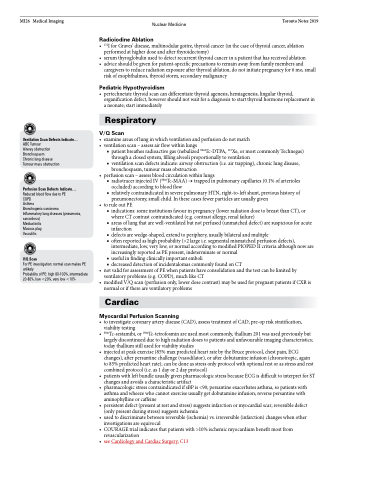Page 694 - TNFlipTest
P. 694
MI26 Medical Imaging
Nuclear Medicine Toronto Notes 2019
Radioiodine Ablation
• 131IforGraves’disease,multinodulargoitre,thyroidcancer(inthecaseofthyroidcancer,ablation performed at higher dose and after thyroidectomy)
• serumthyroglobulinusedtodetectrecurrentthyroidcancerinapatientthathasreceivedablation
• adviceshouldbegivenforpatient-specificprecautionstoremainawayfromfamilymembersand
caregivers to reduce radiation exposure after thyroid ablation, do not initiate pregnancy for 6 mo, small risk of exophthalmos, thyroid storm, secondary malignancy
Pediatric Hypothyroidism
• pertechnetatethyroidscancandifferentiatethyroidagenesis,hemiagenesis,lingularthyroid, organification defect, however should not wait for a diagnosis to start thyroid hormone replacement in a neonate; start immediately
Respiratory
V/Q Scan
• examineareasoflunginwhichventilationandperfusiondonotmatch
Ventilation Scan Defects Indicate...
ABC Tumour
Airway obstruction Bronchospasm
Chronic lung disease Tumour mass obstruction
Perfusion Scan Defects Indicate...
Reduced blood flow due to PE
COPD
Asthma
Bronchogenic carcinoma
Inflammatory lung diseases (pneumonia, sarcoidosis)
Mediastinitis Mucous plug Vasculitis
V/Q Scan
For PE investigation: normal scan makes PE unlikely
Probability of PE: high 80-100%, intermediate 20-80%, low <20%, very low <10%
•
•
•
• •
Myocardial Perfusion Scanning
• toinvestigatecoronaryarterydisease(CAD),assesstreatmentofCAD,pre-opriskstratification, viability testing
• 99mTc-sestamibi,or99mTc-tetrofosminareusedmostcommonly,thallium201wasusedpreviouslybut largely discontinued due to high radiation doses to patients and unfavourable imaging characteristics; today thallium still used for viability studies
• injectedatpeakexercise(85%maxpredictedheartratebytheBruceprotocol,chestpain,ECG changes), after persantine challenge (vasodilator), or after dobutamine infusion (chronotropic, again to 85% predicted heart rate); can be done as stress only protocol with optional rest or as stress and rest combined protocol (i.e. as 1 day or 2 day protocol)
• patientswithleftbundleusuallygivenpharmacologicstressbecauseECGisdifficulttointerpretforST changes and avoids a characteristic artifact
• pharmacologicstresscontraindicatedifsBPis<90;persantineexacerbatesasthma,sopatientswith asthma and wheeze who cannot exercise usually get dobutamine infusion; reverse persantine with aminophylline or caffeine
• persistentdefect(presentatrestandstress)suggestsinfarctionormyocardialscar;reversibledefect (only present during stress) suggests ischemia
• usedtodiscriminatebetweenreversible(ischemia)vs.irreversible(infarction)changeswhenother investigations are equivocal
• COURAGEtrialindicatesthatpatientswith>10%ischemicmyocardiumbenefitmostfrom revascularization
• seeCardiologyandCardiacSurgery,C13
ventilationscan–assessairflowwithinlungs
■ patient breathes radioactive gas (nebulized 99mTc-DTPA, 133Xe, or most commonly Technegas)
through a closed system, filling alveoli proportionally to ventilation
■ ventilation scan defects indicate: airway obstruction (i.e. air trapping), chronic lung disease,
bronchospasm, tumour mass obstruction perfusionscan–assessbloodcirculationwithinlungs
■ radiotracer injected IV (99mTc-MAA) → trapped in pulmonary capillaries (0.1% of arterioles occluded) according to blood flow
■ relatively contraindicated in severe pulmonary HTN, right-to-left shunt, previous history of pneumonectomy, small child. In these cases fewer particles are usually given
toruleoutPE
■ indications: some institutions favour in pregnancy (lower radiation dose to breast than CT), or
where CT contrast contraindicated (e.g. contrast allergy, renal failure)
■ areas of lung that are well-ventilated but not perfused (unmatched defect) are suspicious for acute
infarction
■ defects are wedge-shaped, extend to periphery, usually bilateral and multiple
■ often reported as high probability (>2 large i.e. segmental mismatched perfusion defects),
intermediate, low, very low, or normal according to modified PIOPED II criteria although now are
increasingly reported as PE present, indeterminate or normal
■ useful in finding clinically important emboli
■ decreased detection of incidentalomas commonly found on CT
notvalidforassessmentofPEwhenpatientshaveconsolidationandthetestcanbelimitedby ventilatory problems (e.g. COPD), much like CT modifiedV/Qscan(perfusiononly,lowerdosecontrast)maybeusedforpregnantpatientsifCXRis normal or if there are ventilatory problems
Cardiac


